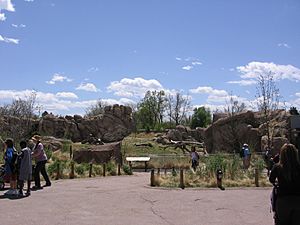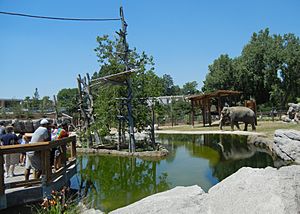Denver Zoo Conservation Alliance facts for kids

Entrance pavilion
|
|
| Date opened | 1896 |
|---|---|
| Location | Denver, Colorado, United States |
| Land area | 80 acres (32 ha) |
| Coordinates | 39°45′N 104°57′W / 39.750°N 104.950°W |
| No. of animals | 2,500 (2024) |
| Annual visitors | 1.8 million (2022) |
| Memberships | AZA, WAZA |
| Major exhibits | Predator Ridge, Tropical Discovery, Toyota Elephant Passage, Primate Panorama, Bear Mountain, Harmony Hill, Down Under |
The Denver Zoo Conservation Alliance is a large 80-acre (32 ha) zoo in Denver, Colorado. It's a special place dedicated to protecting animals and their homes in the wild. The zoo first opened way back in 1896 and is located inside Denver's beautiful City Park. It's the most popular paid attraction in the whole city!
The zoo got its start with a special gift: an orphaned American black bear. From the beginning, the Denver Zoo wanted to create homes for animals that felt like their natural habitats. Instead of small cages with bars, they built large, open spaces. A great example is Bear Mountain, which was one of the first exhibits in the United States to look like a real mountain.
The zoo is a member of important groups like the Association of Zoos and Aquariums (AZA) and the World Association of Zoos and Aquariums (WAZA). This means it meets very high standards for animal care. The zoo also cares a lot about the environment and has won awards for being one of the "greenest" zoos in the country.
History of the Zoo
How It All Began
The Denver Zoo started in 1896 with an American black bear cub named Billy Bryan. The cub was given as a gift to the mayor of Denver, who then gave him to the keeper of City Park. This single bear was the first animal in what would become the Denver Zoo. Soon, other local animals joined, like ducks, prairie dogs, and pronghorn antelope.
For many years, the zoo focused on animals native to Colorado, like large herds of bison and elk. In 1905, they added red squirrels, but the squirrels had so many babies that they started causing problems for the bird population! The zoo had to carefully move the extra squirrels to the nearby mountains.
Building a Modern Zoo
In 1906, Denver's Mayor Robert W. Speer had a big idea. He wanted to get rid of the "prison bars" and create natural-looking homes for the animals. He hired designers to make this happen.
Their most famous creation was Bear Mountain, which opened in 1918. This huge structure was made to look like real mountains near Morrison, Colorado. Instead of bars, hidden moats kept the animals safely in their habitat. It was first home to polar bears and grizzly bears. The exhibit was so amazing that other zoos, like the one in St. Louis, hired its designer to build similar habitats.
One famous resident of Bear Mountain was a polar bear named Velox. She lived there for 20 years and even became the mascot for a U.S. Army group. You can still see a memorial for her at the zoo today.
After Bear Mountain, the zoo continued to grow. Monkey Island was built in 1937. In the 1950s, the zoo got its first elephant, named Cookie. Over the next few decades, many new buildings were added, including the Feline House for big cats, a Giraffe House, and Bird World.
Recent Changes and Events
In 1993, the zoo opened Tropical Discovery, an amazing indoor rainforest. This exhibit is full of fish, reptiles, and other tropical animals. It's like taking a trip to the jungle right in the middle of Denver!
In 1994, twin polar bear cubs named Klondike and Snow were born. Their mother couldn't care for them, so the zoo staff raised them by hand. They became huge stars at the zoo, and a bronze statue was created to remember their story.
Sadly, in 2007, a zookeeper was seriously injured in an accident involving a jaguar and later passed away. The zoo's emergency team responded, but it was a very sad day. The zoo learned from this event to make its safety rules even stronger.
In 2012, the huge Toyota Elephant Passage opened. It's one of the largest habitats for male elephants in the world. In 2024, the zoo announced a major expansion. It received 570 acres of land in a nearby county. This new area, called the Lembke Family Preserve, will give the zoo more space to breed endangered animals and help return them to the wild.
Amazing Animal Exhibits
Primate Panorama
Primate Panorama is a 7-acre area for apes and monkeys. Many of the primates live in giant mesh tents that are four stories high! Inside, animals like Wolf's guenons and siamangs can swing on vines and play. The gorillas have one of the largest gorilla habitats in the world, and the Sumatran orangutans have their own outdoor space to climb.
Nearby, the Emerald Forest building lets you see smaller rainforest animals like the rare aye-aye, tamarins, and sloths. You can also see different kinds of lemurs on a special island.
Africa
Predator Ridge is an exciting exhibit that looks like the African savanna. It's home to lions and spotted hyenas. The animals are rotated between different habitats, which keeps them active and curious. You can also see African penguins in their own special habitat with a large pool for swimming.
The zoo also has many African hoofed mammals, like Grevy's zebras, reticulated giraffes, and okapis. Some of these animals share their homes with birds like ostriches and crowned cranes, just like they would in the wild.
Asia
Toyota Elephant Passage is a huge 10-acre exhibit for Asian elephants, greater one-horned rhinos, and Malayan tapirs. The animals can roam along more than two miles of trails. The zoo has the largest bachelor herd (a group of males) of Asian elephants in the world! The exhibit also has islands where gibbons can swing right over your head.
The Edge is a special habitat for the zoo's Amur tigers. It has large pools and even pathways that go over the visitor walkways, so you can see the tigers from below.
Latin America
Tropical Discovery is an indoor building that feels like a real tropical jungle. It's home to reptiles, fish, and amphibians. You can see bats in a dark cave, venomous snakes in a Mayan temple, and colorful poison dart frogs. The building also has a huge Komodo dragon exhibit, home to the world's largest lizards.
Stingray Cove is a seasonal exhibit where you can gently touch and feed stingrays as they swim by in a large, shallow pool.
The zoo also has a beautiful Flamingo Habitat and a modern Sea Lion Habitat with a large saltwater pool and underwater viewing areas.
Into The Wild
This area features many unique birds. At Lorikeet Adventure, you can walk inside a large tent and feed colorful lorikeets. The Avian Propagation Center is a special place where the zoo helps breed rare and endangered birds.
Bear Mountain is a historic exhibit that first opened in 1918. It was one of the first zoo habitats in the country to look like a natural environment. While the bears have moved to a new home, the impressive rock structure is still there for visitors to see.
Down Under
Opened in May 2024, Down Under is a new exhibit that takes you to Australia. You can walk through an area with red kangaroos and wallabies. The exhibit also features rare tree kangaroos and large cassowaries.
Harmony Hill
Harmony Hill is a newer home for the zoo's grizzly bears. The habitat is designed to look like a state park. It also has a special section that looks like a backyard to teach people how to live safely with wildlife.
Other Animals
The Rhino and Hippo Building is home to black rhinos. The zoo's last Nile hippopotamus is scheduled to move to a preserve in Texas in the fall of 2025. The old Feline House is now used for smaller animals, including a Geoffroy's cat that was rescued at the Denver airport.
Fun and Learning
Besides seeing animals, there are other fun things to do at the zoo. You can ride the Conservation Carousel, which has wooden carvings of endangered animals. The Denver Zoo Railroad takes you on a relaxing ride around part of the zoo. There is also a 4D Theater that shows short, exciting movies.
The zoo is very focused on education and conservation. It is part of many programs to save endangered species, like the American bison and the boreal toad. The zoo works with scientists in other countries, like Peru, to help save the rare Lake Titicaca frog.
The zoo's conservation team works on hundreds of projects around the world to protect animals and their habitats.
Special Events
- Boo at the Zoo is a fun Halloween event in October where kids can trick-or-treat at the zoo.
- Zoo Lights happens in December. The zoo is decorated with millions of beautiful, glowing lights, many of which are shaped like animals.
See also
 In Spanish: Zoológico de Denver para niños
In Spanish: Zoológico de Denver para niños














